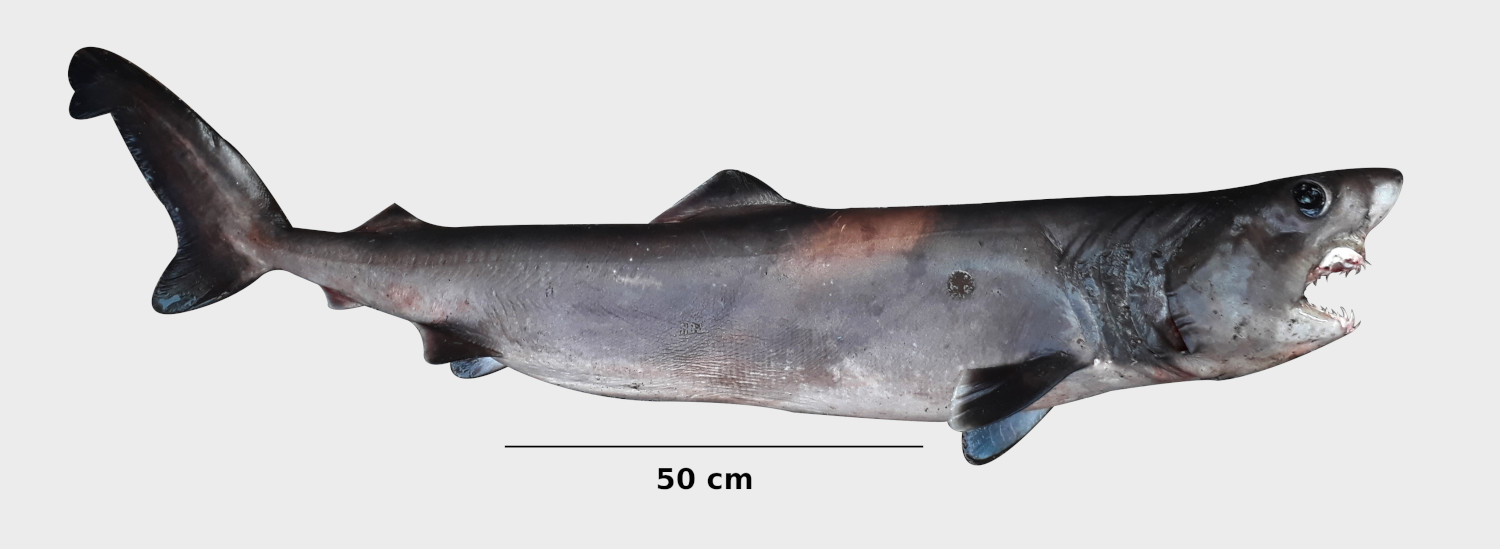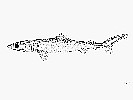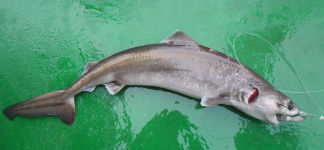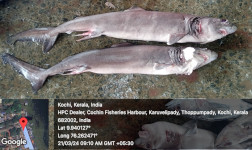Pseudocarcharias kamoharai
(Matsubara, 1936)
Crocodile shark
Classification: Elasmobranchii Lamniformes Pseudocarchariidae
Reference of the original description
A new carcharoid shark found in Japan. Dobutsugaku Zasshi (= Zoological Magazine Tokyo), 48(7), 380–382
A new carcharoid shark found in Japan. Dobutsugaku Zasshi (= Zoological Magazine Tokyo), 48(7), 380–382
Synonyms / new combinations and misspellings
Carcharhinus kamoharai, Carcharias kamoharai, Carcharias yangi, Carcharias (Pseudocarcharias) pelagicus, Odontaspis kamoharai, Pseudocarcharias cf. kamoharai, Pseudocarcharias pelagicus, Pseudocarcharias yangi
Carcharhinus kamoharai, Carcharias kamoharai, Carcharias yangi, Carcharias (Pseudocarcharias) pelagicus, Odontaspis kamoharai, Pseudocarcharias cf. kamoharai, Pseudocarcharias pelagicus, Pseudocarcharias yangi
Types
Pseudocarcharias kamoharai
Holotype: FAKU: 1823 (apparently lost)
Carcharias yangi
Holotype: TFRI: 2895
Pseudocarcharias pelagicus
Holotype: MNHN: 1963-0001
Pseudocarcharias kamoharai
Holotype: FAKU: 1823 (apparently lost)
Carcharias yangi
Holotype: TFRI: 2895
Pseudocarcharias pelagicus
Holotype: MNHN: 1963-0001
Description :
Citation: Pseudocarcharias kamoharai (Matsubara, 1936): In: Database of modern sharks, rays and chimaeras, www.shark-references.com, World Wide Web electronic publication, Version 12/2025
Please send your images of "Pseudocarcharias kamoharai" to info@shark-references.com

Pseudocarcharias kamoharai (Matsubara, 1936), 91 cm TL, male, adult, 2.2 kg whole body weight, off Chennai in the south-east coast of India © K. Silambarasan

Pseudocarcharias kamoharai (Matsubara, 1936), 91 cm TL, male, adult, 2.2 kg whole body weight, off Chennai in the south-east coast of India © K. Silambarasan
Common names
 Tiburón cocodrilo,
Tiburón cocodrilo,  Requin crocodile,
Requin crocodile,  Requin-crocodile,
Requin-crocodile,  Crocodile shark,
Crocodile shark,  Japanese ragged-tooth shark,
Japanese ragged-tooth shark,  Kamohara´s sand-shark,
Kamohara´s sand-shark,  Water crocodile
Water crocodile
 Tiburón cocodrilo,
Tiburón cocodrilo,  Requin crocodile,
Requin crocodile,  Requin-crocodile,
Requin-crocodile,  Crocodile shark,
Crocodile shark,  Japanese ragged-tooth shark,
Japanese ragged-tooth shark,  Kamohara´s sand-shark,
Kamohara´s sand-shark,  Water crocodile
Water crocodile
Short Description
A medium-sized spindle-shaped shark with very large eyes lacking a nictitating membrane, long gill slits extending onto dorsal surface of head, lanceolate teeth, weak keel and precaudal pits on caudal peduncle [1388] [531]. Small and low dorsal fins, with second dorsal fin less than half the size of the first but larger than the anal fin [1388]. Pectoral fin broad and rounded [1388]. Light or dark grey above, paler below, fins white-edged, sometimes with small white spots on body and a white blotch between mouth and gill slits [544].
A medium-sized spindle-shaped shark with very large eyes lacking a nictitating membrane, long gill slits extending onto dorsal surface of head, lanceolate teeth, weak keel and precaudal pits on caudal peduncle [1388] [531]. Small and low dorsal fins, with second dorsal fin less than half the size of the first but larger than the anal fin [1388]. Pectoral fin broad and rounded [1388]. Light or dark grey above, paler below, fins white-edged, sometimes with small white spots on body and a white blotch between mouth and gill slits [544].
Distribution
Tropical and subtropical waters of all oceans.
First record: [159] off Peru, adult male, 830 mm TL, 17°39’S, 71°21’O;
[1484] 960 km off the coast of western Baja California, Mexico LACM 45857-1, 996 mm TL, female, 22 February, 1994;
[2295] caught on the Three Kings Rise, north-east of the Three Kings Islands, New Zealand (32°14.0'S, 172°15.7'), ENMNZ P.37246, male, 1096 mm total length, surface longline set at 120-220 m depth, F.V. Hoshin 58, Ministry of Fisheries observer trip number 1344, set #66; 8 June 2000;
[13522] off northern Chile (22°06´20´´S, 83°32´00´´W), MNHNC P. 7293, female, 920 mm TL, 26.04.2005;
[19673] south-western coast of India (Kerala), by-catch of a deep-water shrimp trawler operated off Cochin; female, 94.5 cm TL, 300–500 m depths, 12.10.2010;
[20584] Chennai, southeast coast of India, male (adult), 91 cm TL, 2.2 kg whole body weight;
[25377] Andaman Sea, Source: www.gbif.org
Tropical and subtropical waters of all oceans.
First record: [159] off Peru, adult male, 830 mm TL, 17°39’S, 71°21’O;
[1484] 960 km off the coast of western Baja California, Mexico LACM 45857-1, 996 mm TL, female, 22 February, 1994;
[2295] caught on the Three Kings Rise, north-east of the Three Kings Islands, New Zealand (32°14.0'S, 172°15.7'), ENMNZ P.37246, male, 1096 mm total length, surface longline set at 120-220 m depth, F.V. Hoshin 58, Ministry of Fisheries observer trip number 1344, set #66; 8 June 2000;
[13522] off northern Chile (22°06´20´´S, 83°32´00´´W), MNHNC P. 7293, female, 920 mm TL, 26.04.2005;
[19673] south-western coast of India (Kerala), by-catch of a deep-water shrimp trawler operated off Cochin; female, 94.5 cm TL, 300–500 m depths, 12.10.2010;
[20584] Chennai, southeast coast of India, male (adult), 91 cm TL, 2.2 kg whole body weight;
[25377] Andaman Sea, Source: www.gbif.org
Human uses
fisheries: minor commercial; price category: not marketed/unknown; price reliability:
fisheries: minor commercial; price category: not marketed/unknown; price reliability:
Biology
Exhibit ovoviparity (aplacental viviparity), with embryos feeding on other ova produced by the mother (oophagy) after the yolk sac is absorbed [733]. With 4 young in a litter, born at 40-43 cm [20053]. An oceanic species usually found offshore and far from land but sometimes occurring inshore. Feeds on small pelagic bony fishes, squids and shrimps.
Exhibit ovoviparity (aplacental viviparity), with embryos feeding on other ova produced by the mother (oophagy) after the yolk sac is absorbed [733]. With 4 young in a litter, born at 40-43 cm [20053]. An oceanic species usually found offshore and far from land but sometimes occurring inshore. Feeds on small pelagic bony fishes, squids and shrimps.
Habitat
pelagic-oceanic; oceanodromous [17660]; marine; depth range 0 - 590 m [1388], usually 0 - 200 m (Ref. 54740)
pelagic-oceanic; oceanodromous [17660]; marine; depth range 0 - 590 m [1388], usually 0 - 200 m (Ref. 54740)
Remarks
shark-references Species-ID=5221;
shark-references Species-ID=5221;
Parasites (arranged by Jürgen Pollerspöck)
Cestoda
Cestoda
- Clistobothrium amyae Caira, Jensen, Hayes & Ruhnke, 2020 [28295]
- Clistobothrium gabywalterorum Caira, Jensen, Hayes & Ruhnke, 2020 [28295]
- Scyphophyllidium timvickiorum Caira, Jensen, Hayes & Ruhnke, 2020 [28295]




















